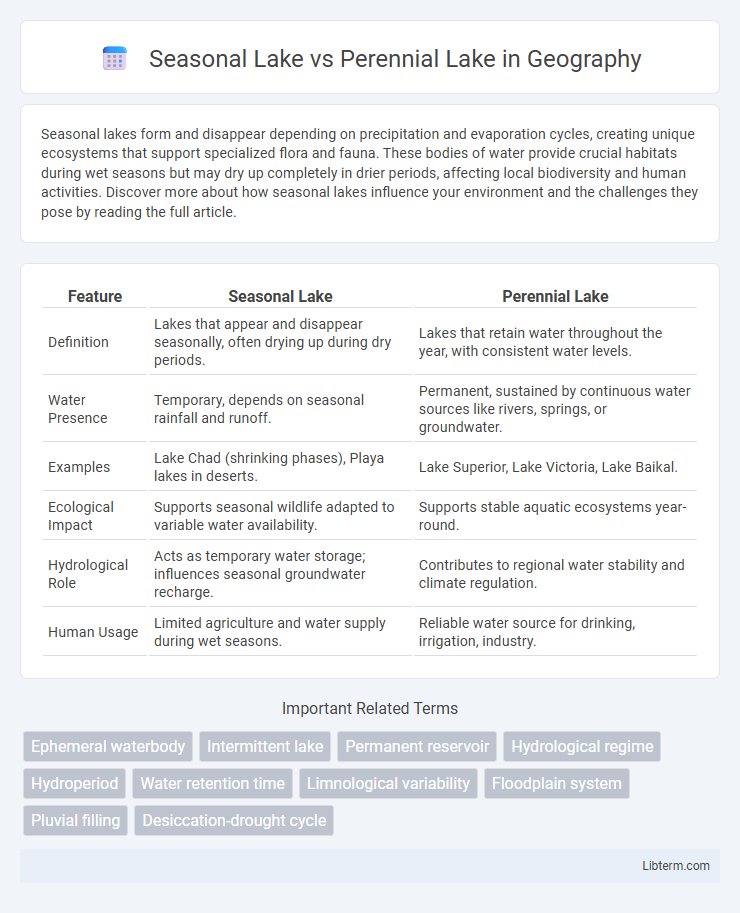Seasonal lakes form and disappear depending on precipitation and evaporation cycles, creating unique ecosystems that support specialized flora and fauna. These bodies of water provide crucial habitats during wet seasons but may dry up completely in drier periods, affecting local biodiversity and human activities. Discover more about how seasonal lakes influence your environment and the challenges they pose by reading the full article.
Table of Comparison
| Feature | Seasonal Lake | Perennial Lake |
|---|---|---|
| Definition | Lakes that appear and disappear seasonally, often drying up during dry periods. | Lakes that retain water throughout the year, with consistent water levels. |
| Water Presence | Temporary, depends on seasonal rainfall and runoff. | Permanent, sustained by continuous water sources like rivers, springs, or groundwater. |
| Examples | Lake Chad (shrinking phases), Playa lakes in deserts. | Lake Superior, Lake Victoria, Lake Baikal. |
| Ecological Impact | Supports seasonal wildlife adapted to variable water availability. | Supports stable aquatic ecosystems year-round. |
| Hydrological Role | Acts as temporary water storage; influences seasonal groundwater recharge. | Contributes to regional water stability and climate regulation. |
| Human Usage | Limited agriculture and water supply during wet seasons. | Reliable water source for drinking, irrigation, industry. |
Introduction to Seasonal and Perennial Lakes
Seasonal lakes are water bodies that appear and disappear depending on precipitation patterns and seasonal changes, often drying up during dry periods. Perennial lakes maintain a consistent water level throughout the year, supported by reliable inflows from rivers, groundwater, or precipitation. Understanding these types is crucial for water resource management and ecological conservation.
Defining Seasonal Lakes
Seasonal lakes are characterized by their periodic presence, typically filling with water during wet seasons and drying up during dry periods due to fluctuations in precipitation and evaporation rates. These lakes play a crucial role in local ecosystems by providing temporary habitats for migratory birds and aquatic species adapted to changing water levels. Unlike perennial lakes, which maintain water throughout the year, seasonal lakes exhibit significant variability in size and water volume, influenced by regional climate patterns.
Understanding Perennial Lakes
Perennial lakes maintain water year-round, supported by consistent inflow from rivers, streams, or groundwater, providing stable aquatic ecosystems. Their continuous water presence supports diverse flora and fauna, making them crucial for biodiversity and human water supply. Unlike seasonal lakes, which dry up periodically, perennial lakes offer reliable habitats and play a key role in regional climate regulation and water resource management.
Key Differences Between Seasonal and Perennial Lakes
Seasonal lakes exist only during certain times of the year, often filling with water during rainy seasons and drying up in dry periods, whereas perennial lakes retain water throughout the year. Seasonal lakes typically have fluctuating water levels influenced by precipitation and evaporation, while perennial lakes maintain more stable water levels due to constant inflows from rivers, springs, or groundwater. Biodiversity in perennial lakes is generally higher because of consistent aquatic habitats, contrasting with seasonal lakes, which support species adapted to intermittent aquatic environments.
Hydrological Cycles and Water Sources
Seasonal lakes experience fluctuating water levels primarily driven by precipitation patterns, snowmelt, and runoff during wet seasons, often drying out in dry periods due to limited groundwater recharge. Perennial lakes maintain relatively stable water levels year-round, sustained by continuous inflows from rivers, groundwater springs, and consistent rainfall, supporting permanent aquatic ecosystems. Understanding these hydrological cycles and water sources is critical for water resource management and ecosystem conservation in regions containing both lake types.
Ecological Importance of Both Lake Types
Seasonal lakes, which fill with water during wet periods and dry up in droughts, provide critical breeding habitats for amphibians and migratory birds, supporting biodiversity through temporal resource availability. Perennial lakes maintain a consistent water level year-round, offering stable ecosystems that sustain diverse aquatic species and regulate local climate. Both lake types contribute to nutrient cycling and groundwater recharge, playing vital roles in maintaining regional ecological balance.
Flora and Fauna Adaptations
Seasonal lakes support flora and fauna adapted to fluctuating water levels, with many species exhibiting rapid growth, dormant seed stages, or migration to survive dry periods. Perennial lakes provide stable aquatic ecosystems where plants such as submerged macrophytes and animals including fish, amphibians, and invertebrates develop permanent, complex habitats. Adaptations in seasonal lakes often include drought-resistant plants and amphibians with life cycles synchronized to wet phases, while perennial lake species exhibit traits favoring long-term stability and resource availability.
Human Interaction and Utilization
Seasonal lakes, characterized by fluctuating water levels, influence human activities such as agriculture and fishing, which adapt to wet and dry cycles, while perennial lakes provide consistent water resources supporting year-round irrigation, recreation, and urban water supply. Communities near seasonal lakes develop strategies like rainwater harvesting and crop rotation to cope with water variability, whereas perennial lakes enable stable infrastructure development and continuous economic activities. The distinct hydrological patterns of each lake type dictate local water management policies, impacting settlement patterns and resource utilization.
Environmental Challenges and Conservation
Seasonal lakes face environmental challenges such as fluctuating water levels, habitat loss for aquatic species, and increased vulnerability to pollution during dry periods. Perennial lakes maintain more stable ecosystems but are susceptible to issues like eutrophication, invasive species proliferation, and climate change-induced temperature shifts. Conservation efforts prioritize maintaining water quality, protecting native biodiversity, and implementing adaptive management strategies tailored to each lake type's hydrological patterns.
Conclusion: The Role of Lakes in Ecosystem Health
Seasonal lakes provide critical breeding grounds and nutrient-rich habitats during wet periods, supporting diverse flora and fauna adapted to fluctuating water levels. Perennial lakes maintain stable water conditions year-round, offering consistent habitats that sustain aquatic ecosystems and biodiversity. Both lake types play essential roles in ecosystem health by regulating hydrological cycles, supporting wildlife, and maintaining water quality.
Seasonal Lake Infographic

 libterm.com
libterm.com